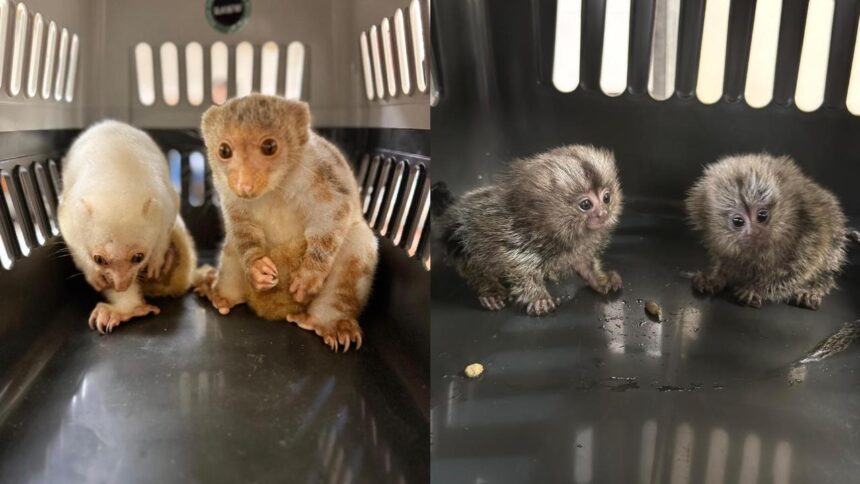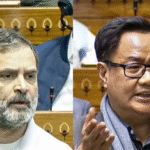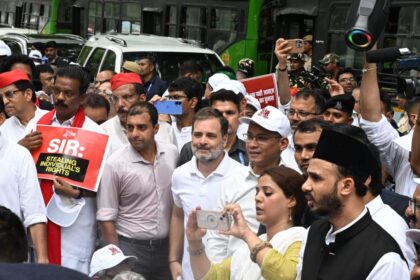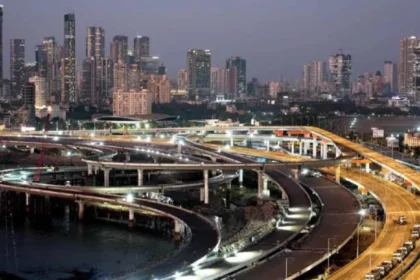Mumbai Customs Arrest Passenger for Smuggling Exotic Wildlife from Bangkok
A Shocking Arrest at Mumbai Airport
The bustling Chhatrapati Shivaji Maharaj International Airport (CSMIA) in Mumbai is no stranger to high-profile seizures. Yet, on a humid evening that seemed like any other, the city’s customs officials made a startling discovery — one that would expose a growing and deeply concerning trend in international wildlife crime. A passenger arriving from Bangkok, Thailand, was apprehended for attempting to smuggle exotic wildlife species into India. The arrest, which quickly made headlines, has since sparked broader discussions about illegal wildlife trade routes, the demand for exotic pets, and the loopholes in enforcement systems that allow such activities to persist.
According to official sources, the passenger was intercepted after intelligence inputs suggested possible illegal activity on the flight in question. Upon inspection of the luggage, customs officers found live exotic animals carefully concealed in a manner designed to avoid detection. These creatures — some endangered, others banned from trade under international conventions — were found cramped inside small boxes and hidden compartments, deprived of adequate ventilation and care.
This incident, while shocking in itself, is part of a much larger and more dangerous problem: the global smuggling network that treats rare wildlife as high-value commodities, akin to narcotics or precious gems.
How the Operation Unfolded
Customs officers at Mumbai airport operate under a constant pressure of vigilance. Every day, thousands of passengers pass through the arrival gates, and in most cases, routine checks are conducted at random. However, certain passengers attract attention due to suspicious travel patterns, inconsistent declarations, or prior intelligence alerts.
In this case, the passenger in question had arrived on a late-night flight from Bangkok, a city that has long been identified as a major hub for the illegal wildlife trade in Southeast Asia. Upon arrival, he appeared unusually nervous and tried to avoid eye contact with security personnel — a subtle behavioral cue that trained officers are quick to notice.
Customs sources revealed that his luggage was put through a scanner, where officers detected irregular shapes that did not correspond with the declared contents. This triggered a manual inspection, leading to the discovery of the exotic animals. The officers acted swiftly, ensuring that the creatures received immediate veterinary attention while the suspect was detained for questioning.
Details of the Seized Wildlife
While customs officials have not disclosed every species seized for security and investigation purposes, preliminary reports suggest that the consignment included a mix of exotic reptiles and birds. Some of these species are listed under the Convention on International Trade in Endangered Species of Wild Fauna and Flora (CITES) Appendix I and II — categories that impose strict bans or controls on international trade.
Wildlife experts consulted after the seizure noted that smuggled species from Bangkok often include:
- Rare reptiles such as iguanas, monitor lizards, and pythons.
- Exotic birds like macaws, cockatoos, and hornbills.
- Small mammals such as sugar gliders and hedgehogs.
The animals were reportedly transported in cramped, makeshift cages with inadequate air circulation. Such conditions not only cause immense suffering to the animals but also pose serious health risks to humans, as exotic species can carry zoonotic diseases — pathogens that can jump from animals to humans.
The Growing Trend of Exotic Wildlife Smuggling into India
Over the last decade, India has seen a steady rise in cases of exotic wildlife smuggling. This is driven by a dangerous combination of high domestic demand for unusual pets, gaps in legislation, and the lucrative profits that traffickers can earn in black markets.
A report by the Wildlife Crime Control Bureau (WCCB) highlights that most of these animals enter the country through air routes, with Bangkok, Kuala Lumpur, and Dubai being the primary points of origin. Once inside India, the animals are sold to wealthy collectors, private zoos, or individuals seeking rare pets for status symbolism.
Unlike indigenous species, which are protected under India’s Wildlife Protection Act, 1972, exotic species are not always covered by the same legal safeguards unless they are listed under CITES. This legal grey area often allows smugglers to exploit loopholes in enforcement.
The Role of CITES and International Regulations
CITES is a global agreement between governments aimed at ensuring that international trade in wild animals and plants does not threaten their survival. India is a signatory to CITES, meaning it is obligated to regulate and monitor the import, export, and re-export of species listed under the convention.
The passenger in this case had no permits for the animals, making the import both illegal and punishable under Indian law. This violation could lead to prosecution under multiple statutes, including the Customs Act, 1962, and sections of the Wildlife Protection Act if the species are on the Indian protected list.
Challenges Faced by Customs and Enforcement Agencies
While this case was a success story for Mumbai Customs, it also highlights the immense challenges faced by enforcement agencies in curbing wildlife trafficking. Smugglers often use sophisticated concealment methods, forged documents, and even corrupt networks to bypass inspections.
Some common tactics include:
- Concealing animals inside electronic equipment or hollowed-out luggage.
- Using courier services or air cargo to ship wildlife.
- Splitting consignments across multiple carriers to reduce risk.
Moreover, detection requires specialized training — scanning equipment may not always pick up live animals if they are small and hidden among other items. This is why intelligence gathering and international cooperation remain critical.
Public Reaction and Outrage
News of the arrest spread quickly across social media and news outlets, triggering a wave of public outrage. Animal rights activists condemned the act, calling for stricter penalties and better awareness campaigns to discourage people from purchasing exotic pets.
Prominent voices from the conservation community urged the government to plug legislative gaps and to introduce stricter licensing requirements for owning exotic animals. They pointed out that while the Wildlife Protection Act is robust in protecting native species, it must evolve to cover exotic species more comprehensively to prevent their exploitation.
Next Steps in the Investigation
As per standard protocol, the arrested passenger will face interrogation to determine the origins of the animals, the intended buyers in India, and whether he was part of a larger organized network. The consignment’s route will also be traced, which could lead to further arrests both domestically and abroad.
If convicted, the suspect could face heavy fines, imprisonment, and a permanent ban on international travel. Authorities have also indicated that the animals will be placed in quarantine for health checks before being rehabilitated in specialized rescue centers.
Following the high-profile arrest at Mumbai airport, the case quickly expanded into a broader investigation involving multiple law enforcement agencies. Customs officials, wildlife crime control authorities, and the Directorate of Revenue Intelligence began coordinating efforts to trace the smuggling network’s roots. The exotic wildlife seized from the Bangkok flight was sent to expert veterinarians for health checks, while forensic specialists analyzed the origins of the species to determine whether they came from illegal poaching hotspots in Southeast Asia.
Investigators uncovered that the detained passenger was likely acting as a courier for a larger syndicate specializing in the illicit trade of endangered species. This syndicate reportedly operated through well-structured smuggling channels, exploiting gaps in airport screening systems and using concealed compartments in luggage to evade detection. The preliminary evidence suggested links to organized wildlife trafficking networks that had been under surveillance for months.
Legally, the accused now faces charges under multiple sections of the Wildlife (Protection) Act, 1972, the Customs Act, 1962, and provisions under the Convention on International Trade in Endangered Species of Wild Fauna and Flora (CITES), to which India is a signatory. These charges carry severe penalties, including imprisonment of up to seven years and heavy fines. Authorities have emphasized that the prosecution will seek maximum punishment to send a clear message against such offenses.
The case has also triggered discussions within policy circles on tightening airport wildlife smuggling detection protocols. Proposals include increased use of advanced scanning technology, more frequent intelligence-sharing between customs units in different countries, and specialized training for security personnel to spot unconventional trafficking methods.
As the investigation progressed, it became increasingly evident that the arrest at Mumbai airport was just the tip of the iceberg. Intelligence gathered from the suspect’s phone records, travel history, and encrypted messaging applications revealed a sophisticated smuggling syndicate with deep international connections. The network spanned across Thailand, Malaysia, Indonesia, and the Middle East, using Mumbai as a critical transit point for moving exotic wildlife to lucrative markets in Europe and the United States.
Undercover operations were launched in collaboration with the Wildlife Crime Control Bureau (WCCB) and Interpol’s Environmental Security Unit. Posing as buyers, undercover agents infiltrated online forums and private social media groups where illegal wildlife trade deals were being negotiated. They discovered that the syndicate operated in a multi-tiered structure—poachers and trappers sourced the animals from biodiversity-rich regions, middlemen managed transportation and bribery logistics, and high-level financiers coordinated international shipments.
These findings pointed to a disturbing trend: the illegal wildlife trade was increasingly intertwined with other forms of organized crime, including drug smuggling and money laundering. Syndicates were using the same trafficking routes and corrupt officials to move both contraband animals and narcotics, making enforcement far more challenging.
Simultaneously, Indian authorities reached out to Thai and Malaysian law enforcement agencies to trace the origins of the seized animals. Preliminary DNA testing confirmed that several species were on the brink of extinction, amplifying the urgency of dismantling the smuggling chain. Coordinated raids in Bangkok and Kuala Lumpur led to additional arrests and the seizure of exotic reptiles, rare birds, and protected mammals.
Public awareness campaigns were also initiated, warning travelers about the legal and ethical implications of participating in the wildlife trade. Officials stressed that even purchasing exotic animals as “pets” contributed to a destructive black-market ecosystem.
The arrest quickly escalated into one of the most closely watched wildlife crime cases in recent years. The accused, still in judicial custody, was presented before the Mumbai Metropolitan Magistrate’s Court under multiple provisions of the Wildlife Protection Act, 1972, and the Customs Act, 1962. Prosecutors argued that this was not an isolated incident but part of a larger, highly organized transnational smuggling network, making the offense both severe and non-bailable.
During the initial hearings, the defense attempted to portray the accused as a “mere courier” unaware of the contents of his luggage. They claimed he was hired by an unidentified “travel agency” to transport sealed crates and had no knowledge that the cargo contained exotic wildlife. However, prosecutors countered with damning evidence: intercepted phone conversations, financial transactions traced through hawala channels, and CCTV footage from Bangkok’s Suvarnabhumi Airport showing the accused personally supervising the loading of the animal crates.
The case attracted extensive media coverage, with news channels broadcasting updates and investigative reports daily. Wildlife activists staged demonstrations outside the court, demanding stringent punishment and warning against leniency, arguing that such crimes fuel biodiversity loss and disrupt fragile ecosystems.
Public sentiment was overwhelmingly in favor of strong action. On social media, hashtags like #StopWildlifeSmuggling and #JusticeForWildlife trended for days. Celebrities and environmentalists joined the campaign, urging the judiciary to set a precedent by delivering the maximum penalty permissible under law.
Meanwhile, the court ordered the seized animals to be placed under the care of the Byculla Zoo and specialized wildlife rescue centers. Veterinarians worked round-the-clock to rehabilitate the creatures, many of which were severely dehydrated, malnourished, or traumatized from the inhumane conditions of transport.
The trial was adjourned multiple times as authorities awaited additional evidence from foreign investigative agencies. But each court date kept the case in the public eye, with growing calls for India to strengthen its anti-smuggling laws and impose harsher penalties on offenders.
As the case unfolded, it began to attract attention far beyond India’s borders. Reports indicated that the smuggling route involving the accused was part of a much larger Southeast Asia–South Asia wildlife trafficking corridor, which had long been on the radar of Interpol, the ASEAN Wildlife Enforcement Network, and the UN Office on Drugs and Crime (UNODC). Bangkok authorities, after reviewing the evidence provided by Indian customs, confirmed that multiple similar consignments had passed through their airport in recent months, often linked to syndicates operating out of Myanmar, Laos, and Vietnam.
The Ministry of External Affairs (MEA) in New Delhi opened diplomatic communication with Thai authorities to establish a joint investigative task force. This cooperation aimed to dismantle not just the middlemen but also the masterminds who funded and orchestrated the smuggling operations. These talks were conducted quietly but decisively, with Indian officials pressing for the extradition of certain high-value suspects believed to be hiding in Bangkok and Pattaya.
Parallel to the diplomatic engagement, India’s Ministry of Environment, Forest and Climate Change (MoEFCC) initiated discussions on strengthening the Wildlife Protection Act. Proposed amendments included increasing maximum prison terms for exotic species trafficking from seven years to a minimum of ten years, imposing heavier fines, and introducing fast-track courts for wildlife crimes. Lawmakers argued that such measures would not only deter offenders but also send a clear message to international syndicates that India would not serve as a weak link in their global smuggling chain.
International NGOs like WWF, TRAFFIC, and the International Union for Conservation of Nature (IUCN) welcomed these developments. They pledged technical and financial support for wildlife rescue, rehabilitation, and monitoring programs. The Indian government also began exploring advanced cargo scanning technologies at airports and seaports, including AI-powered X-ray systems capable of detecting live animals in concealed containers.
Meanwhile, within India, public activism showed no signs of slowing down. Environmental groups submitted petitions to Parliament, demanding a national database of exotic wildlife imports and a permanent ban on the private ownership of endangered foreign species. They argued that such a registry would close the loopholes often exploited by traffickers under the guise of “legal breeding” or “pet trade.”
The accused, still in custody, faced mounting charges as new evidence surfaced linking him to previous shipments of exotic birds and reptiles. The pressure from both domestic and international bodies ensured that the investigation remained a priority for enforcement agencies.
Coordinated Raids, Key Arrests, and the Unmasking of the Network
Following weeks of intelligence gathering and cross-agency coordination, law enforcement initiated a series of synchronized raids across multiple Indian cities — Mumbai, Delhi, Kolkata, and Chennai being the primary hotspots. The Directorate of Revenue Intelligence (DRI), Wildlife Crime Control Bureau (WCCB), and local police units worked in tandem, backed by real-time updates from customs surveillance teams. These operations were executed in the early hours of the morning to minimize the risk of evidence destruction or suspect flight.
In Mumbai’s Andheri suburb, investigators stormed a warehouse where they discovered concealed compartments lined with soundproofing material — specifically designed to hide exotic birds and small mammals. In Delhi, a luxury farmhouse doubled as an illegal breeding and holding facility for endangered reptiles imported from Southeast Asia. The raids yielded not only live animals but also a trove of falsified CITES (Convention on International Trade in Endangered Species) certificates, suggesting that the network had a sophisticated document-forging wing.
One of the most significant breakthroughs came from Chennai, where authorities arrested a middle-ranking operative who agreed to cooperate with investigators in exchange for a reduced sentence. His testimony mapped out the chain of command: from poachers and middlemen in Thailand and Laos, to transporters who specialized in “clean” air routes, to Indian receivers who distributed the wildlife to buyers ranging from private collectors to underground exotic pet markets.
Forensic financial analysis revealed the use of shell companies and cryptocurrency wallets to launder payments. Investigators traced several transactions to overseas accounts in Singapore and Dubai, confirming suspicions that the operation had deep transnational roots. Indian cybercrime units also uncovered encrypted chat groups where syndicate members coordinated shipments, evaded detection, and discussed prices for rare species in coded terms.
The arrests were not limited to handlers and transporters. In a decisive move, authorities apprehended two businessmen from Mumbai and Hyderabad, suspected to be the primary financiers of the smuggling chain within India. Their involvement marked a shift in the case from low-level enforcement to the prosecution of high-value targets who sustained the trade financially.
The rescued wildlife — including rare macaws, slow lorises, albino pythons, and star tortoises — were sent to specialized rehabilitation centers across India. Wildlife veterinarians worked around the clock to stabilize the animals, many of which were malnourished and dehydrated from their trafficking ordeal. The rehabilitation process was closely monitored by both government agencies and accredited NGOs to ensure transparency.
Public reaction to the raids was overwhelmingly supportive. Media coverage highlighted the scale and cruelty of the trade, fueling calls for even harsher penalties. Hashtags demanding a permanent ban on private ownership of exotic species trended nationally, amplifying the pressure on policymakers.







